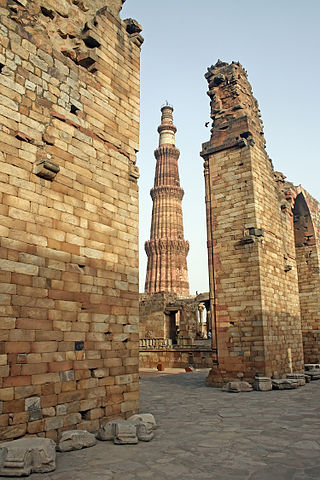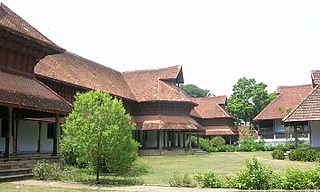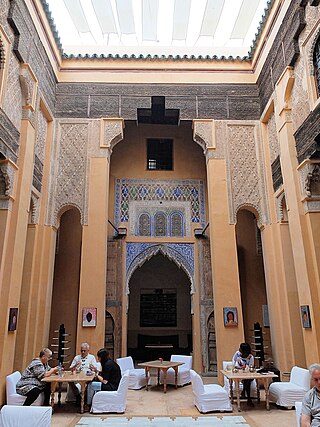
BAPS Shri Swaminarayan Mandir is a Hindu temple in Neasden, London, England. Built entirely using traditional methods and materials, the Swaminarayan mandir has been described as being Britain's first authentic Hindu temple. It was also Europe's first traditional Hindu stone temple, as distinct from converted secular buildings. It is a part of the Bochasanwasi Shri Akshar Purushottam Swaminarayan Sanstha (BAPS) organisation and was inaugurated in 1995 by Pramukh Swami Maharaj. The temple complex also consists of a permanent exhibition entitled "Understanding Hinduism" and a cultural centre housing an assembly hall, gymnasium, bookshop, and offices.

The Qutb Minar complex are monuments and buildings from the Delhi Sultanate at Mehrauli in Delhi, India. Construction of the Qutub Minar "victory tower" in the complex, named after the religious figure Sufi Saint Khwaja Qutbuddin Bakhtiar Kaki, was begun by Qutb-ud-din Aibak, who later became the first Sultan of Delhi of the Mamluk dynasty. It was continued by his successor Iltutmish, and finally completed much later by Firoz Shah Tughlaq, a Sultan of Delhi from the Tughlaq dynasty (1320–1412) in 1368 AD. The Qubbat-ul-Islam Mosque, later corrupted into Quwwat-ul Islam, stands next to the Qutb Minar.

The Hawa Mahal is a palace in the city of Jaipur, Rajasthan, India. Built from red and pink sandstone, it is on the edge of the City Palace, Jaipur, and extends to the Zenana, or women's chambers.

The Sun Temple of Modhera is a Hindu temple dedicated to the solar deity Surya located at Modhera village of Mehsana district, Gujarat, India. It is situated on the bank of the river Pushpavati. It was built after 1026-27 CE during the reign of Bhima I of the Chaulukya dynasty. No worship is offered now and it is a protected monument maintained by the Archaeological Survey of India. The temple complex has three components: Gūḍhamanḍapa, the shrine hall; Sabhamanḍapa, the assembly hall and Kunḍa, the reservoir. The halls have intricately carved exterior and pillars. The reservoir has steps to reach the bottom and numerous small shrines.

Bhaja Caves are a group of 22 rock-cut caves dating back to the 2nd century BC located off the Mumbai - Pune expressway near the city of Pune, India. The caves are 400 feet above the village of Bhaja, on an important ancient trade route running from the Arabian Sea eastward into the Deccan Plateau. The inscriptions and the cave temple are protected as a Monument of National Importance, by the Archaeological Survey of India per Notification No. 2407-A. It belongs to the Early Buddhist schools in Maharashtra. The caves have a number of stupas, one of their significant features. The most prominent excavation is its chaitya, a good example of the early development of this form from wooden architecture, with a vaulted horseshoe ceiling. Its vihara has a pillared verandah in front and is adorned with unique reliefs. These caves are notable for their indications of the awareness of wooden architecture. The carvings prove that tabla – a percussion instrument – was used in India for at least 2300 years, disproving the centuries-held belief that the tabla was introduced to India by outsiders or from Turko-Arab. The carving shows a woman playing tabla and another woman, performing dance.

Kuthiramalika is a Travancore Kingdom palace built by Swathi Thirunal Rama Varma on the south-eastern side of Padmanabhaswamy temple, Thiruvananthapuram. Kuthira Malika translates to 'Mansion of horses', and it has been named so because of the 122 horses that adorn the many pillars that support the southern roof of this majestic structure.

Sethi Mohallah, sometimes called Sethian Mohallah, is an old and traditionally arranged neighbourhood in the old city of Peshawar, Pakistan. The mohallah contains seven South Asian mansions built by the Sethi family that were built in a style reminiscent of Central Asia with elaborate wooden carvings. The houses were completed in the late 19th century.

The Mahadeva Temple is located in the town of Itagi in Yelburga Taluk, in the Koppal District of Karnataka state, India. It is about 7 km (4 mi) from Kuknur and 20 km (12 mi) from Lakkundi.

The Bou Inania Madrasa or Bu 'Inaniya Madrasa is a madrasa in Fes, Morocco, built in 1350–55 CE by Abu Inan Faris. It is the only madrasa in Morocco which also functioned as a congregational mosque. It is widely acknowledged as a high point of Marinid architecture and of historic Moroccan architecture generally.

The Al-Attarine Madrasa or Medersa al-Attarine is a madrasa in Fes, Morocco, near the Al-Qarawiyyin Mosque. It was built by the Marinid sultan Uthman II Abu Said in 1323-5. The madrasa takes its name from the Souk al-Attarine, the spice and perfume market. It is considered one of the highest achievements of Marinid architecture due to its rich and harmonious decoration and its efficient use of limited space.

Vaso is a Village located in Kheda district of Gujarat, India. nearest City is Nadiad and Kheda. Vaso Is Tehsil Of Kheda district Of Gujarat State.

Hutheesing Temple is a Jain temple in Ahmedabad in Gujarat, India. It was constructed in 1848 by the Hutheesing family. The temple blends the old Maru-Gurjara temple architecture style with new architectural elements of haveli in its design.

Firoz Shah palace complex (Hisar-e-Firoza) is an archaeological complex located in modern-day Hisar, in the Haryana state of India, built by Firoz Shah Tughlaq of the Delhi Sultanate in 1354 AD. It is maintained by the Archaeological Survey of India.

Nagina Mosque is a mosque in Champaner, Gujarat, India. It was built during the time of Mahmud Begada, in the 15th century, as were several other masjids, such as the Kevada, Bawaman, Ek Minar, Jama, Khajuri, and Shahar Ki. It has minarets, globe-like domes, and narrow stairs. It is part of the Champaner-Pavagadh Archaeological Park, a UNESCO World Heritage Site.

Sheikh Chilli's Tomb is complex of structures located in Thanesar, in the Kurukshetra district of Haryana, India. It includes two tombs, a madrasa, Mughal gardens and various subsequent features.

Adhai Din Ka Jhonpra is a historical mosque in the city of Ajmer in Rajasthan, India. It is one of the oldest mosques in India, and the oldest surviving monument in Ajmer.

The Haveli of Nau Nihal Singh, officially known as Government Victoria Girls' High School, is a haveli (mansion) that houses a government school located in Lahore, Punjab, Pakistan.
Haveli Dharampura, built in 1887 CE and currently owned by BJP leader Vijay Goel, is a 19th-century haveli in Chandani Chowk area of old Delhi that as awarded a special mention in UNESCO Asia-Pacific Awards for Cultural Heritage Conservation in 2017.

The Madrasa of Abu al-Hasan, also referred to as the Marinid Madrasa , is a medieval madrasa located within the old city of Salé, Morocco. It was built in the 14th century by the Marinid sultan Abu al-Hasan next to the Grand Mosque of Salé and it is notable for its rich decoration.

Dar Cherifa, historically known as Dar Ijimi, is a late 16th-century house in the medina of Marrakesh, Morocco. It is located in the Mouassine neighbourhood and is one of the few well-preserved houses from the Saadian period in the city. In recent years it has been restored and is now used as a café and art gallery.



















